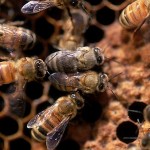Where Have All the Honeybee’s Gone?
These are honey bees.

If you are under thirty, chances are your great grandchildren will never see one. That’s because they are vanishing. Though the number of bees world wide has been declining for years, 2006 marked their march toward extinction. No definitive cause has been found. Scientists have called the inexplicable die-off, “colony collapse disorder,” a term that encompasses pesticides, viruses and poor nutrition. Some even postulate that radiation levels from mobile phones or power cables are the cause. In other words, no one can explain what’s happening to our honeybees.
A common saying is that one out of every three bites you put in your mouth comes from crops pollinated by bees. More than ninety fruits, vegetables and nuts depend on bees for pollination though some are pollinated by wind.
Commercial beekeepers maintain numerous colonies and ship them all over the world to pollinate much of the spring blossoming nuts, berries and vegetables. This year, Pennsylvania beekeepers have reported losing up to one third of their livestock, half again more than last year. English beekeepers have lost half of their hives over the last twenty years.
Could genetically modified food be the cause of the die offs? In 2006, 33% of the world’s Corn and Cotton crops were modified with Bacillus thurngiensis (BT) which coincidentally coincides with the bee destruction.
In a small ray of hope last week, the United States Department of Agriculture announced they would survey thirteen states in an effort to find out what is killing the bees. One can only hope the results don’t come too late.
You probably couldn’t care less if your heirs ever see a bat, but you should. They too are dying off, many from white nose syndrome, a fungus that has already killed more than a million brown cave bats. Losing the bat populations of the world would have a devastating effect on ecosystems. One small, brown bat can eat more than one thousand mosquitoes in an hour. Bats pray on vast numbers of night flying insects many of which cause serious damage to potato, corn and wheat crops as well as our gardens and forests.
Wyoming is currently suffering an onslaught of grasshoppers. The land owners place the blame on two much rain but scientific studies show that overgrazed range lands, lack of grass and plowed sandy soil that blows away are the major contributing factor. Today, crop dusters, who earn a dollar per acre, are spraying millions of acres with diflubenauron to kill the grasshoppers.
The butterfly populations are declining at an alarming rate. Scientists wonder if they haven’t underestimated the magnitude of the pending extinction of large varieties of species with humans the dominant agent of destruction.
Is there cause for alarm? Yes. When we see bees and bats and butterflies dying in large numbers, we want someone to find out why. We need laws that require us to test the chemicals we so generously sprinkle on and in our food. We must accept once and for all that it is mostly humans changing the world’s climate. And we need every country to sign and abide by the Kyoto Protocol, the international agreement to cut global-warming emissions.
There have been five major extinctions in the past four billion years of life. The first came after the evolution of land based plants. The second caused the formation of the coal forests. Two more occurred before the final extinction of the dinosaurs which was probably caused by the earth’s collision with a meteor. Now, according to Dr. Sandy Knapp of the Natural History Museum we are poised on the verge of the sixth extinction crisis. . . .“Britain, by virtue of its well-known and well-studied biodiversity, is the canary for the rest of the globe. . . . The warning is there for all to see,” Some think that by the end of this century, fifty percent of earth’s species will have gone extinct.
Let’s not let that happen.
 Bumble Bee, most likely a Queen, on our Stella d’Oro day lily
Bumble Bee, most likely a Queen, on our Stella d’Oro day lily



Leave a Reply